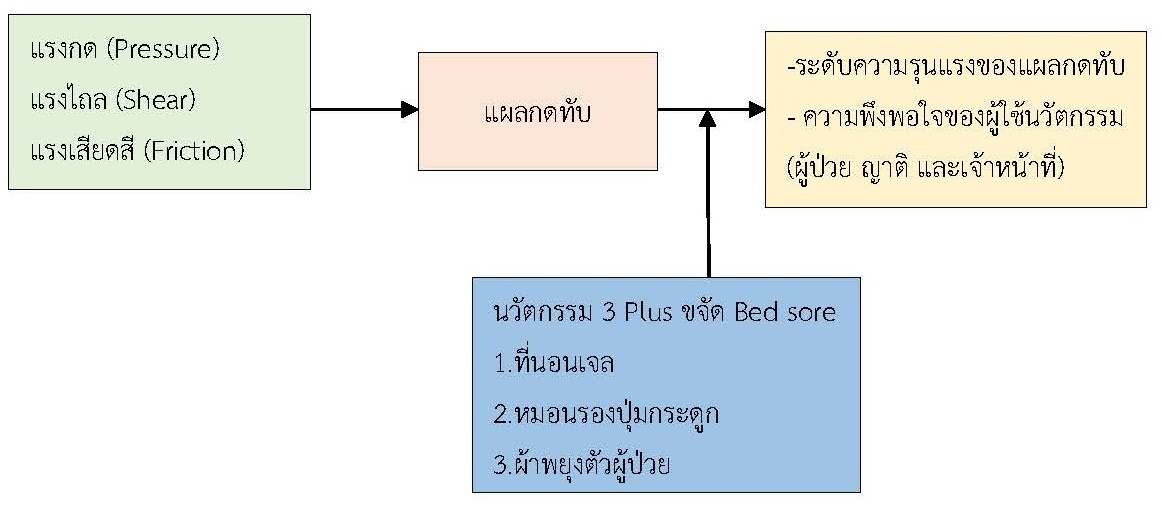The Effects of Applying the 3-Plus Innovation to Eliminate Bed Sore on Reducing the Severity of Pressure Sores and the Satisfaction of Innovative Users in the Female Medicine Unit, Thabo Crown Prince Hospital
Keywords:
Clinical Practice Guideline in Using Innovation, 3-Plus Innovation, Bed Sore, SatisfactionAbstract
The objectives of this quasi-experimental research with a one-group pretest-posttest design were to examine the effects of applying the 3-Plus innovation to eliminate bed sores on reducing the severity of pressure sores and the satisfaction of innovative users in the female medicine unit, Thabo Crown Prince Hospital. Participants were selected using a purposive sampling technique, consisting of 34 patients with pressure sores, aged 15 years and over and having a Braden Score less than or equal to 16 points. The research instrument was the 3-plus innovation to eliminate bed sores, consisting of gel mattresses, orthopedic pillows, and clothes to support the patient. The data collection tools were the pressure sore surveillance assessment form with a consistency index of 0.76 and the innovation satisfaction assessment form with a Cronbach's alpha coefficient of confidence of 0.81. The data were analyzed using descriptive statistics and the Wilcoxon Signed-Rank test.
The results showed that after applying the 3-Plus innovation to eliminate bedsore, the pressure ulcer severity of the patients decreased at a statistically significant level of 0.01. The average satisfaction score of innovative users was at a very good level in six aspects, namely prevention of pressure sores, minimization of violence, economics, and safety, as well as wanting to continue using the innovation and wanting to take it back to use at home. Therefore, health care teams can apply this innovation to care for patients with pressure sores both in the hospital and at home, as well as expand the results to be used in sub-district health promotion hospitals to reduce the number of patients with pressure sores.
References
จรรยา ชูวิทยาพงศ์. (2560). ผลของโปรแกรมการดูแลผิวหนังร่วมกับการใช้เบาะยางรถจักรยานใส่น้ำหุ้มด้วยเสื่อกระจูดเพื่อป้องกันการเกิดแผลกดทับในผู้สูงอายุที่นอนติดเตียง. วิทยานิพนธ์พยาบาลศาสตร มหาบัณฑิต. มหาวิทยาลัยสงขลานครินทร์.
ปรีดา กังแฮง. (2562). นวัตกรรมที่นอนลดหรือรักษาแผลกดทับ. วารสารกรมการแพทย์, 44(1), 52-56.
ปัญญาภัทร ภัทรกัณทากุล. (2555). ผลของการใช้นวัตกรรมที่นอนยางรถเพื่อป้องกันแผลกดทับในผู้ป่วยที่มีความเสี่ยงต่อการเกิดแผลกดทับ. วารสารพยาบาลกระทรวงสาธารณสุข, 22(1), 48-60.
พรทิพย์ สารีโส, ปิยภร ไพรสนธิ์ และอโนทัย เฉลิมศรี. (2559). ประสิทธิผลการป้องกันการเกิดแผลกดทับของที่นอนชนิดไม่มีการเคลื่อนที่ของลมและชนิดที่มีการเคลื่อนที่ของลม: การศึกษาเบื้องต้น. วารสารสภาการพยาบาล, 31(3), 83-96.
พิมพ์นิภา ศรีนพคุณ, นวพร วุฒิธรรม และสุภรินทร์ ใจพรมเมือง. (2564). ประสิทธิผลของโปรแกรมการพยาบาล “นวัตกรรมที่นอนยางห่างหายแผลกดทับ” ในผู้ป่วยกลุ่มเสี่ยงต่อการเกิดแผลกดทับ. พยาบาลสาร, 48(4), 294-307.
พุทธชาติ ใจกาศ. (2561). นวัตกรรม “3P” กระดาษป้องกันการปนเปื้อนแผลกดทับบริเวณก้นกบ. วชิรสารการพยาบาล, 20(2), 50-54.
Best, J. W. (1997). Research in education. (3rd ed). New Jersey: Prentice-Hall.
Braden, B., & Bergstrom, N. (2000). A conceptual schema for the study of the etiology of pressure sores. Rehabilitation Nursing, 25(3), 105-110.
Cohen, J. (1988). Statistical power analysis for the behavioral sciences. (2nd). Hillsdale, New Jersey: Lawrence Erlbaum Associates, Publishers.
Dongpho, P. (2019). Effectiveness of clinical practice guidelines implementation for pressure sore preventation. Thammasat Medical Journal, 19(2), 315-323.
Faul, F., Erdfelder, E., Lang, A. G., & Buchner, A. (2007). G*Power 3: A flexible statistical power analysis program for the social, behavioral, and biomedical sciences. Behavior Research Methods, 39(2), 175-191. doi: 10.3758/bf03193146.
Huang, L., et al. (2023). Summary of best evidence for prevention and control of pressure ulcer on support surfaces. International Wound Journal, 20(6):2276-2285. doi: 10.1111/iwj.14109.
Mervis, J. S., & Phillips, T. J. (2019). Pressure ulcers: Prevention and management. Journal of the American Academy of Dermatology, 81(4), 893–902. https://doi.org/10.1016/j.jaad.2018.12.068

Downloads
Published
How to Cite
Issue
Section
License
Copyright (c) 2023 Journal of Nursing and Public Health Research

This work is licensed under a Creative Commons Attribution-NonCommercial-NoDerivatives 4.0 International License.
1. บทความหรือข้อคิดเห็นใด ๆ ที่ปรากฏในวารสารวิจัยการพยาบาลและการสาธารณสุข ที่เป็นวรรณกรรมของผู้เขียน บรรณาธิการไม่จำเป็นต้องเห็นด้วย
2. บทความที่ได้รับการตีพิมพ์ถือเป็นลิขสิทธิ์ของ วารสารวิจัยการพยาบาลและการสาธารณสุข








